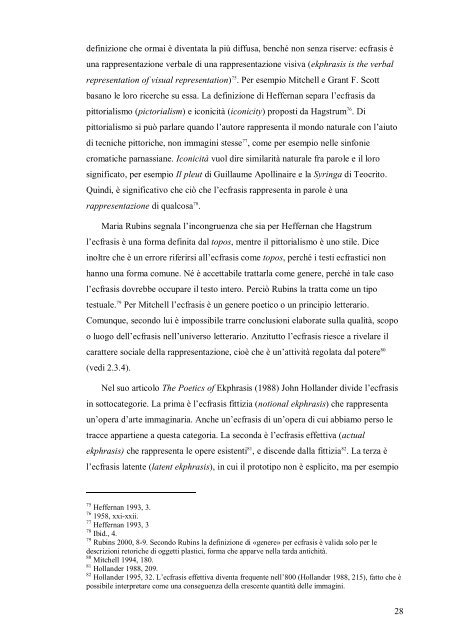L'ecfrasis nel Piacere di Gabriele d'Annunzio - E-thesis
L'ecfrasis nel Piacere di Gabriele d'Annunzio - E-thesis
L'ecfrasis nel Piacere di Gabriele d'Annunzio - E-thesis
Create successful ePaper yourself
Turn your PDF publications into a flip-book with our unique Google optimized e-Paper software.
definizione che ormai è <strong>di</strong>ventata la più <strong>di</strong>ffusa, benché non senza riserve: ecfrasis è<br />
una rappresentazione verbale <strong>di</strong> una rappresentazione visiva (ekphrasis is the verbal<br />
representation of visual representation) 75 . Per esempio Mitchell e Grant F. Scott<br />
basano le loro ricerche su essa. La definizione <strong>di</strong> Heffernan separa l’ecfrasis da<br />
pittorialismo (pictorialism) e iconicità (iconicity) proposti da Hagstrum 76 . Di<br />
pittorialismo si può parlare quando l’autore rappresenta il mondo naturale con l’aiuto<br />
<strong>di</strong> tecniche pittoriche, non immagini stesse 77 , come per esempio <strong>nel</strong>le sinfonie<br />
cromatiche parnassiane. Iconicità vuol <strong>di</strong>re similarità naturale fra parole e il loro<br />
significato, per esempio Il pleut <strong>di</strong> Guillaume Apollinaire e la Syringa <strong>di</strong> Teocrito.<br />
Quin<strong>di</strong>, è significativo che ciò che l’ecfrasis rappresenta in parole è una<br />
rappresentazione <strong>di</strong> qualcosa 78 .<br />
Maria Rubins segnala l’incongruenza che sia per Heffernan che Hagstrum<br />
l’ecfrasis è una forma definita dal topos, mentre il pittorialismo è uno stile. Dice<br />
inoltre che è un errore riferirsi all’ecfrasis come topos, perché i testi ecfrastici non<br />
hanno una forma comune. Né è accettabile trattarla come genere, perché in tale caso<br />
l’ecfrasis dovrebbe occupare il testo intero. Perciò Rubins la tratta come un tipo<br />
testuale. 79 Per Mitchell l’ecfrasis è un genere poetico o un principio letterario.<br />
Comunque, secondo lui è impossibile trarre conclusioni elaborate sulla qualità, scopo<br />
o luogo dell’ecfrasis <strong>nel</strong>l’universo letterario. Anzitutto l’ecfrasis riesce a rivelare il<br />
carattere sociale della rappresentazione, cioè che è un’attività regolata dal potere 80<br />
(ve<strong>di</strong> 2.3.4).<br />
Nel suo articolo The Poetics of Ekphrasis (1988) John Hollander <strong>di</strong>vide l’ecfrasis<br />
in sottocategorie. La prima è l’ecfrasis fittizia (notional ekphrasis) che rappresenta<br />
un’opera d’arte immaginaria. Anche un’ecfrasis <strong>di</strong> un’opera <strong>di</strong> cui abbiamo perso le<br />
tracce appartiene a questa categoria. La seconda è l’ecfrasis effettiva (actual<br />
ekphrasis) che rappresenta le opere esistenti 81 , e <strong>di</strong>scende dalla fittizia 82 . La terza è<br />
l’ecfrasis latente (latent ekphrasis), in cui il prototipo non è esplicito, ma per esempio<br />
75<br />
Heffernan 1993, 3.<br />
76<br />
1958, xxi-xxii.<br />
77<br />
Heffernan 1993, 3<br />
78<br />
Ibid., 4.<br />
79<br />
Rubins 2000, 8-9. Secondo Rubins la definizione <strong>di</strong> «genere» per ecfrasis è valida solo per le<br />
descrizioni retoriche <strong>di</strong> oggetti plastici, forma che apparve <strong>nel</strong>la tarda antichità.<br />
80<br />
Mitchell 1994, 180.<br />
81<br />
Hollander 1988, 209.<br />
82<br />
Hollander 1995, 32. L’ecfrasis effettiva <strong>di</strong>venta frequente <strong>nel</strong>l’800 (Hollander 1988, 215), fatto che è<br />
possibile interpretare come una conseguenza della crescente quantità delle immagini.<br />
28
















